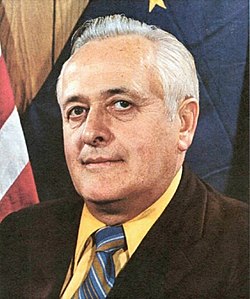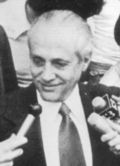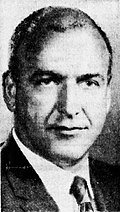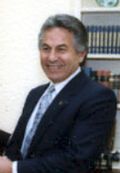Top Qs
Timeline
Chat
Perspective
1974 United States gubernatorial elections
From Wikipedia, the free encyclopedia
Remove ads
United States gubernatorial elections were held on November 5, 1974, in 35 states and two territories. The Democrats achieved a net gain of four seats, Republicans took a net loss of five seats, and one Independent was elected to the governorship of a state. This election coincided with the Senate and the House elections.
In Iowa, Kansas, South Dakota and Texas, governors were elected to four-year terms for the first time, instead of two-year terms. As of 2025, this is the last time that a Democrat was elected South Dakota governor. This is the first time a woman has been elected governor whose husband was not governor of any state. (In this case, Connecticut.)
Remove ads
Election results
States
Territories and federal district
Remove ads
Closest races
States where the margin of victory was under 1%:
- Alaska, 0.3%
- Ohio, 0.37%
- Kansas, 0.47%
- Arizona, 0.85%
States where the margin of victory was under 5%:
- New Mexico, 1.14%
- New Hampshire, 2.36%
- Guam, 2.8%
- Maine, 2.81%
- California, 2.86%
- South Carolina, 3.27%
- Michigan, 4.32%
States where the margin of victory was under 10%:
- South Dakota, 7.22%
- Colorado, 7.57%
- Pennsylvania, 8.55%
- Hawaii, 9.16%
Alabama
The 1974 Alabama gubernatorial election took place on November 5, 1974. Incumbent Democratic governor George Wallace was reelected in a landslide over his Republican opponent, businessman and former state senator Elvin McCary. Wallace was the first Alabama governor to win election to a second consecutive term, as the state's Constitution was amended in 1968 to allow governors to serve a maximum two elected consecutive terms. This was also Wallace's first campaign after having been paralyzed following being shot by Arthur Bremer in an assassination attempt during Wallace's run for the 1972 Democratic presidential nomination.
Alaska
Summarize
Perspective
The 1974 Alaska gubernatorial election took place on November 5, 1974, for the post of Governor of Alaska. Republican challenger and mayor of Bristol Bay Borough Jay Hammond narrowly beat Democratic incumbent Bill Egan in a close race that was forced into a recount to verify the results. The formation of the new Alaskan Independence Party was considered to have a large impact on the race. Hammond had defeated former governors Wally Hickel and Keith Harvey Miller for the Republican nomination, while Egan defeated Eben Hopson and Don Wright for the Democratic nomination.
Remove ads
Arizona
Summarize
Perspective
The 1974 Arizona gubernatorial election took place on November 5, 1974. Incumbent Governor Jack Williams decided not to run for a fourth term as governor. Former United States Ambassador to Bolivia Raúl Héctor Castro, who was the Democratic nominee in 1970, won the Democratic nomination again in 1974, and narrowly won the general election, defeating Republican nominee Russell Williams by 0.85%. Castro was sworn into his first and only term as governor on January 6, 1975.
Prior to the election, there was a recall effort led by Cesar Chavez against incumbent Governor Jack Williams, with 180,000 signatures submitted. Many of the signatures were invalidated by the Attorney General Gary Nelson, but this was eventually overturned. By the time this occurred, however, it was meaningless due to the close proximity of the 1974 gubernatorial election, and thus a recall election did not occur.[36]
Approximately two years into his term as governor, Castro would resign to become United States Ambassador to Argentina.
Remove ads
Arkansas
The 1974 Arkansas gubernatorial election was held on November 5, 1974. Incumbent Democratic Governor Dale Bumpers retired to run for the U.S. Senate. Democratic nominee David Pryor defeated Republican nominee Ken Coon with 65.57% of the vote.
Remove ads
California
The 1974 California gubernatorial election took place on November 5, 1974. The primary elections occurred on June 4, 1974. Incumbent Governor and former actor Ronald Reagan retired after two terms. Democratic Secretary of State Jerry Brown, son of former Governor Pat Brown, defeated Republican Controller Houston I. Flournoy in the general election. This is the first election since 1958 to not feature a Republican candidate that went on to become a U.S. president.
Remove ads
Colorado
The 1974 Colorado gubernatorial election was held on November 5, 1974. Democratic nominee Richard Lamm defeated incumbent Republican John D. Vanderhoof with 53.22% of the vote.
Remove ads
Connecticut
Summarize
Perspective
The 1974 Connecticut gubernatorial election was held on November 5, 1974. Democratic nominee Ella Grasso defeated Republican nominee Robert H. Steele with 58.35% of the vote. Grasso thus became the first woman to be elected Governor of Connecticut and the first woman elected governor of a US state who was not the spouse or widow of a former Governor.
Florida
The 1974 Florida gubernatorial election took place on November 5, 1974. Incumbent Democratic Governor Reubin Askew won re-election to a second term.
Remove ads
Georgia
The 1974 Georgia gubernatorial election was held on November 5, 1974. Under Georgia's constitution at the time, incumbent Democratic governor Jimmy Carter was ineligible to serve a second consecutive term. He was elected President of the United States in the 1976 presidential election. George Busbee was elected as the 77th Governor of Georgia.
Remove ads
Hawaii
Summarize
Perspective
The 1974 Hawaii gubernatorial election was Hawaii's fifth gubernatorial election. The election was held on November 5, 1974, and resulted in a victory for the Democratic candidate, Lt. Gov. George Ariyoshi over Republican candidate, former State Senator Randolph Crossley.[37] Ariyoshi received more votes than Crossley in every county in the state.[38]
Although he was by law Lieutenant Governor of Hawaii at the time of this election, George Ariyoshi had had all the power and responsibility of the Governorship since October 26, 1973, when Governor John A. Burns was incapacitated due to illness and Ariyoshi was made acting governor.[39][40]
This was Crossley's second failed attempt to win the Governorship, having previously lost the 1966 election.
Idaho
The 1974 Idaho gubernatorial election was held on Tuesday, November 5. Incumbent Democrat Cecil Andrus soundly defeated Republican nominee Jack Murphy, the lieutenant governor, with 70.92% of the vote.[41][42][43][44]
Iowa
The 1974 Iowa gubernatorial election was held on November 5, 1974. Incumbent Republican Robert D. Ray defeated Democratic nominee James Schaben with 58.07% of the vote.
Kansas
The 1974 Kansas gubernatorial election was held on November 5, 1974. Republican nominee Robert Frederick Bennett narrowly defeated Democratic nominee Vern Miller with 49.5% of the vote.
Maine
Summarize
Perspective
The 1974 Maine gubernatorial election took place on November 5, 1974. Incumbent Democratic Governor Kenneth M. Curtis was term-limited and could not seek re-election. Independent candidate James B. Longley defeated Democratic Party challenger (and future Senate Majority Leader) George J. Mitchell and Republican James Erwin in a tight three-way contest. Longley's victory made him the first independent (non-party-affiliated) governor in Maine's history.
Maryland
The 1974 Maryland gubernatorial election was held on November 5, 1974. Incumbent Democrat Marvin Mandel defeated Republican nominee Louise Gore with 63.50% of the vote.
Massachusetts
The 1974 Massachusetts gubernatorial election was held on November 5, 1974. Michael Dukakis was elected to a four-year term, from January 2, 1975 until January 4, 1979. He defeated incumbent Governor of Massachusetts Francis W. Sargent in the general election.
Michigan
The 1974 Michigan gubernatorial election was held on November 5, 1974. William Milliken was elected to his second term as Governor of Michigan in a rematch with Sander Levin.[45] This was the last time until 1990 that the state elected a governor of the same party as the sitting president.
Minnesota
The 1974 Minnesota gubernatorial election took place on November 5, 1974. The 1974 election was the first election where the Governor and Lieutenant Governor ran on the same ticket. Minnesota Democratic–Farmer–Labor Party candidate Wendell Anderson defeated Republican Party of Minnesota challenger John W. Johnson.
Nebraska
Summarize
Perspective
The 1974 Nebraska gubernatorial election was held on November 5, 1974, and featured incumbent Governor James Exon, a Democrat, defeating Republican nominee, state Senator Richard D. Marvel. Independent state Senator Ernie Chambers also captured 5% of the vote as a write-in candidate. This was the first gubernatorial election in Nebraska in which the nominees for Governor and Lieutenant Governor ran as a single ticket in the general election, though they were chosen in separate primary elections.
Nevada
The 1974 Nevada gubernatorial election occurred on November 5, 1974. Incumbent Democrat Mike O'Callaghan successfully ran for re-election to a second term as Governor of Nevada, defeating Republican nominee Shirley Crumpler and Independent American nominee James Hay Houston.
New Hampshire
The 1974 New Hampshire gubernatorial election was held on November 5, 1974. Incumbent Republican Governor Meldrim Thomson Jr. defeated Democratic nominee Richard W. Leonard with 51.15% of the vote.
New Mexico
The 1974 New Mexico gubernatorial election took place on November 5, 1974, in order to elect the Governor of New Mexico. Due to term limits, incumbent Democrat Bruce King was ineligible to seek a second term as governor. Democrat Jerry Apodaca narrowly defeated Republican Joe Skeen. This election saw Hidalgo County vote for a Republican gubernatorial candidate for the first time ever.
New York
Summarize
Perspective
The 1974 New York gubernatorial election was held on November 5, 1974 to elect the Governor and Lieutenant Governor of New York. Incumbent Republican governor Malcolm Wilson, who had ascended to the governorship following Nelson Rockefeller's resignation to begin work with the Commission on Critical Choices for Americans in 1973, was defeated by Democratic Hugh Carey. Carey became the first Democratic Governor of New York since W. Averell Harriman left office in 1958 after suffering defeat from Nelson Rockefeller in the election that same year.
Ohio
The 1974 Ohio gubernatorial election was held on November 5, 1974. Republican nominee Jim Rhodes narrowly defeated Democratic incumbent John J. Gilligan with 48.62% of the vote.
Oklahoma
The 1974 Oklahoma gubernatorial election was held on November 5, 1974, and was a race for Governor of Oklahoma. Democrat David Boren defeated Clem McSpadden in a run-off to claim his party's nomination after embattled incumbent David Hall was eliminated in the initial primary. Boren won the general election handily over Republican Jim Inhofe.,[46] who later won a 1994 U.S. Senate special election triggered by Boren's impending resignation to become the University of Oklahoma's president.
Oregon
The 1974 Oregon gubernatorial election took place on November 5, 1974. Democratic nominee Robert Straub, endorsed by the outgoing governor Tom McCall, defeated Republican nominee Victor Atiyeh.
Pennsylvania
The 1974 Pennsylvania gubernatorial election was held on November 5. Incumbent Democratic Governor Milton Shapp defeated Republican Drew Lewis. Under the state's 1968 constitution, Shapp was the first governor who was eligible to run for consecutive terms.[47][48]
Rhode Island
The 1974 Rhode Island gubernatorial election was held on November 5, 1974. Incumbent Democrat Philip Noel defeated Republican nominee James W. Nugent with 78.48% of the vote.
South Carolina
The 1974 South Carolina gubernatorial election was held on November 5, 1974 to select the governor of the state of South Carolina. Initially considered a longshot candidate,[49] Republican James B. Edwards defeated Democrat W. J. Bryan Dorn with a narrow majority of the vote.
South Dakota
Summarize
Perspective
The 1974 South Dakota gubernatorial election was held on November 5, 1974, to elect a Governor of South Dakota. This election was the first in South Dakota to elect the governor for a four-year term, after it was allowed by a constitutional amendment passed in 1972.[50] Democratic nominee and Governor Richard F. Kneip was re-elected, defeating Republican nominee John E. Olson. As of 2024[update], this is the last time that a Democrat was elected Governor of South Dakota, marking the start of the longest Republican winning streak in the country for a state's governorship, as well as the longest gubernatorial winning streak by a single party.
Tennessee
The 1974 Tennessee gubernatorial election was held on November 5, 1974, to elect the next governor of Tennessee. Incumbent Republican governor Winfield Dunn was ineligible to run for re-election, as the Constitution of Tennessee prohibited governors from serving consecutive terms at the time. Democratic nominee Ray Blanton defeated Republican opponent Lamar Alexander with 55.4% of the vote.
Texas
The 1974 Texas gubernatorial election was held on November 5, 1974, to elect the governor of Texas. Incumbent Democratic governor Dolph Briscoe was easily re-elected to a second term, winning 61% of the vote to the 31% of Republican Jim Granberry, the former mayor of Lubbock. Raza Unida candidate Ramsey Muniz won 6%, while the remaining 2% were cast for other candidates.[51]
Vermont
The 1974 Vermont gubernatorial election took place on November 5, 1974. Incumbent Democrat Thomas P. Salmon ran successfully for a second term as Governor of Vermont, defeating Republican candidate Walter L. Kennedy and Liberty Union candidate Martha Abbott.
Wisconsin
The 1974 Wisconsin gubernatorial election was held on November 5, 1974. Democrat Patrick Lucey won the election with 53% of the vote, winning his second term as Governor of Wisconsin and defeating Republican William Dyke.[52]
Wyoming
The 1974 Wyoming gubernatorial election took place on November 5, 1974. Incumbent Republican Stanley Hathaway chose to retire than run for a third term as Governor of Wyoming. Former Democratic State Representative Edgar Herschler defeated former Republican State Senator Dick Jones.
Territories and federal district
District of Columbia
Washington, D.C., held its first direct election for its mayor on November 5, 1974. It followed the passage of the District of Columbia Home Rule Act by the U.S. Congress in 1973. The election was won by Walter Washington, a Democrat. Washington won the Democratic nomination in a seven-candidate primary election in which his most significant opponent was Clifford Alexander Jr..
Guam
See also
Notes
- Vanderhoof took office after his predecessor (John Arthur Love) resigned.
- Sargent took office after his predecessor (John Volpe) resigned.
- Milliken took office after his predecessor (George W. Romney) resigned.
- Wilson took office after his predecessor (Nelson Rockefeller) resigned.
References
Wikiwand - on
Seamless Wikipedia browsing. On steroids.
Remove ads













































































































